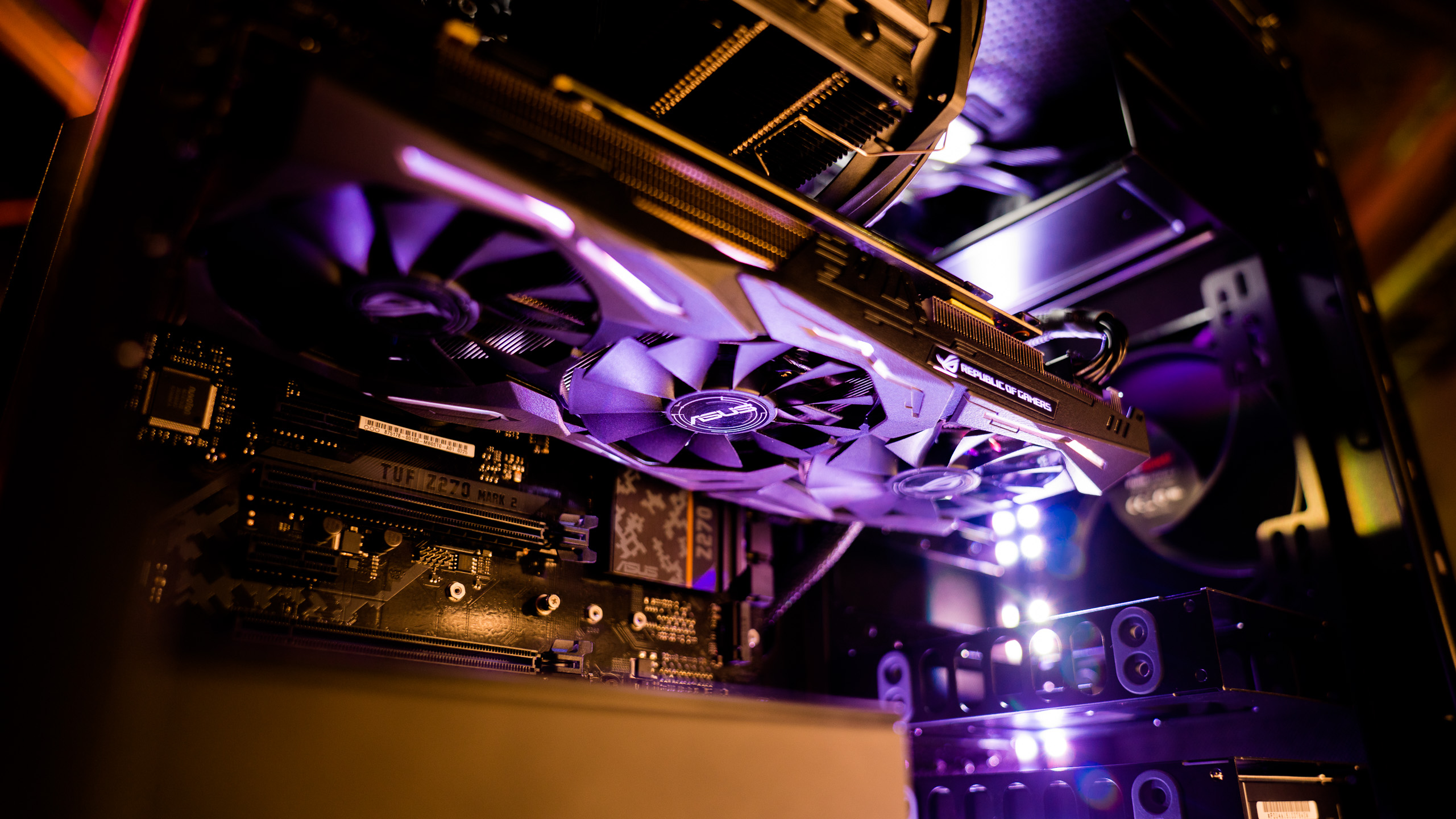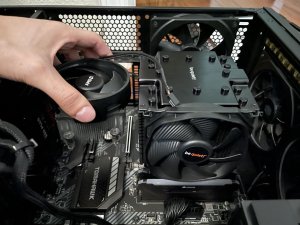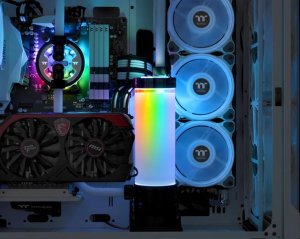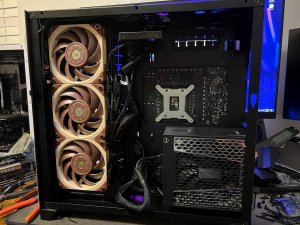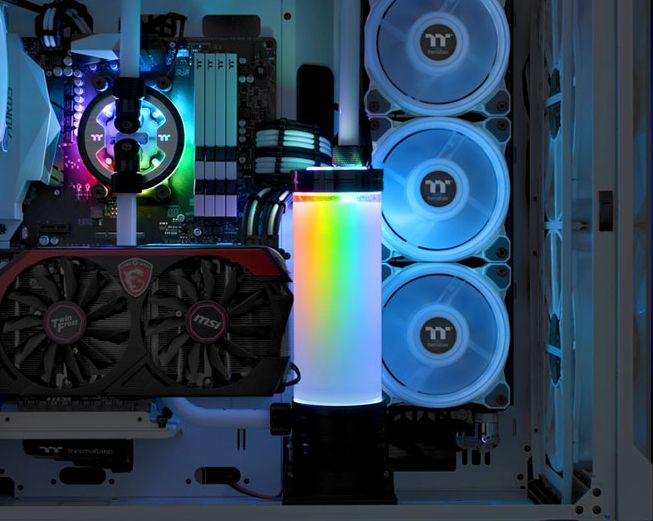
Building a PC can be a daunting task, thanks to the vast number of choices on the market. But building a quiet PC makes things even harder, especially if you’re looking at higher end equipment for gaming and streaming. In order to help you build a quiet PC, we’ll break down which parts you’ll need to pay attention to, as well as additional ways you can help keep your PC quiet.
Choosing Quiet PC Parts

Noctua NF-A14 140mm Case Fan
Use Larger and Quieter Fans
One of the simplest and easiest ways to spec out a quiet build is to use larger and quieter fans. Larger fans are capable of moving more air at lower RPMs, allowing them to run much quieter than smaller fans that spin faster.
But even at larger sizes, not all fans are created equally. Fans like the Noctua NF-A14 are high-end fans that offer a better airflow-to-noise ratio than comparable fans, thanks to better engineering and superior durability.
Pick the Right GPU and CPU Cooler
Aside from case fans, air coolers and graphics cards follow a similar principle. Since you won’t find too many modern GPUs or CPU coolers that are both passive and capable of handling heavy workloads (the Noctua NH-P1 notwithstanding), you’ll want to find ones with large and quiet fans.
For CPU coolers, you have options like the Scythe Fuma 2, or the be quiet! Dark Rock Pro 4. Both of these are premium air coolers that are capable of handling heavy loads while remaining practically silent, thanks to their multiple large and relatively silent fans.
As for GPUs, you can find cards like the ASUS RTX 3070 TUF Gaming OC V2 or Red Dragon RX 6800 that max out at a paltry 28 dB and 31 dB under load, respectively, thanks to their large fans. And of course, you can always forego air cooling for liquid cooling, for a potentially quieter setup.
Run a Custom Liquid Cooling Loop
No matter which way you spin it, liquid cooling blows air cooling out of the water in terms of cooling performance. However, liquid cooling is only as quiet as the components it uses.
Along with fans mounted to the radiator to provide proper heat exchange between the warm liquid in the loop and the cooler surrounding air, liquid cooling systems also add pumps to the mix. And this means another potential source of noise inside your PC.
With that said, if you’re looking to use liquid cooling for a quiet PC build, then you should consider a custom liquid cooling loop with a large radiator and as many fans as possible to keep things quiet. Do note that building a custom loop takes added skill and patience.
While all-in-one (AIO) liquid coolers are cheaper and more convenient than custom loops, they also have a tendency to get louder than air cooling systems. This is due to having less fluid than custom loops, along with higher-RPM fans and potentially loud pumps. You can certainly replace an AIO’s stock fans with quieter fans, but you’re still limited in the amount of fluid inside the cooler and with the pump it comes with.
Custom cooling loops, on the other hand, work much more efficiently than AIO coolers, allowing you to create a quieter liquid cooling setup. Not only do they have a higher volume of liquid coolant, which makes for superior thermals over AIOs and air coolers, but they also allow you to choose a quiet pump.
Of course, a custom cooling loop is a lot more expensive and complicated to set up. But if you value silence over convenience, and you’re prepared to take the time and risk in setting up a proper custom loop, then it’s certainly the best way to bring noise levels down to a minimum.
Choose a Quiet Case
When building a quiet PC, you’ll want to select a case that is conducive to a quiet build. Quiet cases can come in two forms: restricted airflow cases and high airflow cases.
Restricted airflow cases reduce noise by restricting airflow and positioning vents to reduce the amount of noise that escapes. Restrictive airflow cases, like the be quiet! Silent Base 601, also utilize large, high-end case fans and case insulation to help further reduce noise.
High-airflow cases, on the other hand, offer a more open design and utilize the increased airflow to offer better thermals. Cases like the NZXT H7 Flow allow components to stay cooler, offering more configurable airflow options that, combined with quiet case and component fans, can keep your components cool enough to avoid fans ramping up high enough to be loud.
Of course, both types of cases have their drawbacks as well.
With restricted airflow cases, temperatures tend to get higher, which can cause strain on components and lead to thermal throttling. Meanwhile, open air cases offer superior thermals, but are more susceptible to noise leaks. And while quiet fans can help reduce fan noise to inaudible levels, a high-airflow case, unlike restrictive flow cases, will do nothing to help soften other annoying sounds like coil whine.
Find a Quiet Power Supply
Power supplies are another common source of noise. But unlike other noisy components, there’s generally nothing you can do to make them run quieter, aside from picking a quiet power supply.
If you’re looking for a truly silent build, then you’ll want to get a quality power supply with a high efficiency rating to reduce the amount of wasted power that generates heat. The Seasonic Prime PX-850 is a good example. Not only is it a platinum rated power supply, but it also offers hybrid fan controls, allowing you to set it to where the fan only runs when it’s under a heavy load.
Opt for SSDs (Or Find Quiet HDDs)
In years past, one common and unavoidable source of noise inside a computer was the hard drive. But with the current state of PC storage, you’re no longer limited to spinning rust. With internal SSDs continuing to fall in price while increasing in capacity, there’s hardly a reason to run traditional hard drives in a modern build, especially if you’re aiming for a quiet PC.
However, if you happen to need more than a few terabytes of storage, and you don’t have hundreds of dollars to spend on a larger SSD, then you should at least opt for a quiet hard drive.
Like fans, higher RPM drives generally produce more noise, so a good 5400RPM drive is something to consider for bulk storage. Also, consider using rubber anti-vibration grommets to reduce hard drive vibration inside the PC case.
Further Hushing Your PC
When building a quiet PC, choosing quiet parts is crucial to achieving the goal of a silent build. But you don’t just have to stop at hardware choices. Whether you want to further silence your new quiet PC, or you’re looking to bring noise levels down in an existing rig, there are a couple other things you can do to help tame PC noise.
Tweaking Fan Curves
By now, you’ve probably realized that having fans inside your computer is practically unavoidable. So you pick some good fans that run quiet without sacrificing cooling efficiency. But there’s more you can do here.
Hardware manufacturers include a stock fan curve configuration for their hardware to allow it to run optimally in most systems. But if those preset curves just aren’t cutting it, you can use software like NZXT CAM or Corsair iCue to tweak fan curves to suit your specific noise and cooling needs.
Undervolting Power-hungry Hardware
With the steep power requirements of modern high-end CPUs and GPUs, it’s no wonder why these components run so hot. That’s where undervolting comes into play.
With undervolting, you can throttle the amount of power your CPU and GPU receive. And while it might sound counter-intuitive, this is actually an effective way to reduce the amount of heat these components generate without sacrificing performance, leading to both a cooler and quieter system

